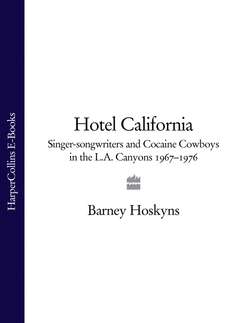Читать книгу Hotel California: Singer-songwriters and Cocaine Cowboys in the L.A. Canyons 1967–1976 - Barney Hoskyns - Страница 14
IV: Human Highway
ОглавлениеJohn Phillips’s hubris was all too clear once the Mamas and Papas’ success waned. His fatal error was his failure to notice the new mood Laurel Canyon represented. For the new back-to-the-earth minstrels – chilling out in split-level cabins with their cats and patched-denim jeans, penning soul-searching songs about themselves and each other
– living in Bel Air and driving a Rolls-Royce simply wasn’t hip. ‘A lot of the music hearkened back to a simpler time and place,’ says Chris Darrow. ‘The style of clothing went back to the Victorian era. We all wanted it to be the way we thought it was in the ’20s or ’30s. We wanted to be cowboys.’
If Laurel Canyon was organic, Topanga Canyon – ten miles west and abutting the Pacific Ocean – was a veritable wilderness. In Laurel Canyon you rode motorcycles; in Topanga you rode horses. This was where you came to get distance from Hollywood. The sound of Topanga was acoustic, laid-back. Weary of amplified bombast, songwriters were reconnecting with their folk roots and dabbling in newly hip country music. ‘One of the reasons people slipped out to Topanga was because you could pretend you were in Kentucky or Tennessee,’ says Dan Bourgoise, then an A&R man for Liberty Records. ‘Everything was getting more woodsy and rustic, and the music got very country.’
Mark Volman of the Turtles, who’d tasted almost as much success as the Monkees and the Mamas and the Papas, was quicker than John Phillips to perceive the general shift in sensibility. ‘What came in at that time was really the foundation for the music of the ’70s,’ Volman reflects now. ‘The Turtles were not connected to that kind of hip counterculture that was beginning to flourish. We were really maybe holdovers from a different era – the last vestiges of that early ’60s Brill Building era.’
The new ethos of singer-songwriters and self-contained bands spelled trouble for the likes of P. F. Sloan and Warren Zevon, who wrote minor hits for the Turtles. ‘I really think that record companies just forgot guys like Phil Sloan,’ says Volman. ‘Dunhill was a very pop record label that didn’t really know how to deal with an artist like him.’ Another successful ‘backroom boy’ in Los Angeles, pop/MOR writer Jimmy Webb, also sensed the wind changing direction. For his first album he penned a lament for Sloan that spoke of the pathos of the hired hand shunted aside by the new, hipper breed of singer-songwriter. ‘I genuinely felt that [Phil’s] was the first – and a very heroic – attempt to break out of the box labelled “pop songwriter”,’ Webb says, ‘and that he should’ve gotten some credit for helping liberate a lot of us.’
Songbird Jackie DeShannon, who’d started out at Metric Music, straddled the two worlds of writing and performing. She was also alert enough, in the fall of 1968, to release an album called Laurel Canyon, complete with a golden-throated paean to the Edenic place she now called home. ‘It was the right time and the right place,’ she stated. ‘All the elements I envisioned fell together.’
Nowhere were the changes felt more keenly than at Warner/Reprise. ‘We just felt we were out on some limb,’ says Stan Cornyn. ‘There was Capitol sitting there having trouble with the Beatles, not to mention Liberty, Dot, ABC and those other floundering labels that didn’t quite get it. We seemed to get it and we were having fun with it.’ Arguably the most catalytic figure at the company, however, was not Lenny Waronker but the svelte, sardonic and very British Andy Wickham. Following the model of Billy James, Reprise head Mo Ostin wanted his own ‘house hippie’ at Reprise and Wickham fit the bill perfectly. ‘Mo had had the very astute realisation that he needed an ambassador to the counterculture,’ says producer Joe Boyd, who first met Ostin and Wickham in late 1967. ‘Mo would hang with people and listen to people and take their cues,’ says Stan Cornyn. ‘Andy was worth listening to. He had real intelligence. What he came up with was generally unknowns.’
Wickham had been a commercial artist in London before working at Immediate Records for Rolling Stones manager Andrew Loog Oldham. A fascination with American culture had brought him out to California – and to a publicity job with Adler’s Dunhill label – in 1965. ‘In those days he already looked like a hippie,’ says singer Ian Whitcomb, a fellow Brit in Hollywood. ‘He was wearing beads and chains and long hair. He loved it in Los Angeles.’ Ostin put Wickham on a generous salary of $200 a week, though Andy’s principal duty was to hang out with musicians in Laurel Canyon and keep his finger firmly on the pulse of the times. As a result, the canyon – in Stan Cornyn’s words – became ‘a Reprise lode of gold’.
‘In my head, Andy took over Laurel Canyon for us,’ Cornyn says. ‘I can’t think of who else really repped us in those narrow-laned hills. He hung there and he had long hair and he did not keep office hours.’ For Mo Ostin and Warner Brothers Records head Joe Smith, Wickham wasn’t the easiest sell to their colleagues. But the Englishman’s track record began to speak for itself. ‘Andy knew about things,’ says Smith. ‘He was our longhaired kid. We guided him through the hostile waters of the rest of the staff, which was a much more establishment group of people.’
It was one of Wickham’s hunches, a young Canadian folk singer, whose arrival in LA in early 1968 would mark the true onset of the Laurel Canyon era. Joni Mitchell’s time had come.
